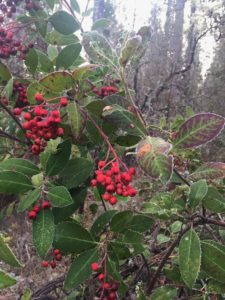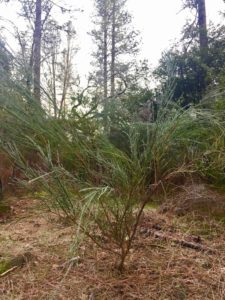By Dorothy Punderson, Education and Outreach Coordinator at Sierra Streams Institute – Nevada City, CA.
Conservation in Your Backyard: Planting Natives is a Win-Win



Toyon – Native Species
A few weeks ago I was outdoors preparing for an upcoming science education field trip with Sierra Streams Institute’s two education directors, Sol Henson and Annika Alexander-Ozinskas. Sol and Annika, both much more familiar with the area than me (I moved to Grass Valley from Vermont last fall), pointed out several species I’d need to know for the field trip: manzanita, with its dusty green leaves, toyon, covered in bright red berries, and giant chain ferns. They also identified stands of scotch broom, a common invasive species in this area.
Invasive species are a major concern for conservationists. While not all introduced species are harmful to an ecosystem, some can overtake native populations, triggering a cascade of consequences for other species. For instance, Scotch broom crowds out other plants that are important food sources for wildlife and grows in highly flammable stands.



Scotch Broom – Invasive Species
Many non-native plants originally came to the US as ornamentals, intended for private gardens and arboretums. As we know, many of these species have escaped captivity. Fortunately, there are several actions homeowners can take to become more familiar with their local ecology and encourage native species to grow in their backyards.
For more information about invasive species in California and how to manage them, check out the California Invasive Plant Council’s website.
For those who enjoy landscaping and gardening, cultivating native plants is a great way to increase habitat resiliency and biodiversity.
Native plants offer many benefits, says Sierra Streams restoration ecologist Shannon Henke. “Native plants provide valuable habitat for birds, pollinators, and other wildlife species, they are adapted to our local environment so they require less water and are more resilient than most cultivated exotic species, and many are very beautiful.”



Shannon Henke, Restoration Ecologist at Sierra Streams Institute
In short, planting natives is a win-win both for other native species and those of us who enjoy colorful, low-maintenance gardens.
The California Native Plant Society offers great resources on how to garden with native plants and where to find nearby nurseries that carry native plants.
Even if you are not much of a green thumb, you can easily familiarize yourself with the species in your backyard. Anyone with a smartphone can identify most native species using a variety of citizen science apps such as iNaturalist, Seek (a branch of iNaturalist designed for kids), or Budburst. These apps rely on AI and verification by other scientists — they are not 100% accurate, but they are a great start for beginning naturalists. You will be amazed at what you can find within just a few hundred yards of your house.
Planting natives and using citizen science technology are just two ways of engaging with the natural world; our community offers many more citizen science opportunities for those who are interested.
For example, Sierra Streams Institute monitors Deer Creek and the Bear River for water quality, information which we use to make sure there are no major sources of pollution and to prioritize restoration sites. Most of our monitoring is done by volunteer citizen scientists. In addition to water quality monitoring, citizen scientists have taken part in wildlife surveys, restoration projects and environmental health studies.
For community members who want to dive deeper into local natural history, Sierra Streams Institute also offers a California Naturalist course each spring in partnership with University of California.



For more information on native plants and citizen science, check out the resources hyperlinked in this article. If you are interested in getting involved with Sierra Streams Institute, you can sign up to volunteer here, find information about our California Naturalist course here, or check out our website and Facebook for general information and upcoming events. We hope some of these resources help you become more familiar with the many incredible ecosystems in the Sierra!




